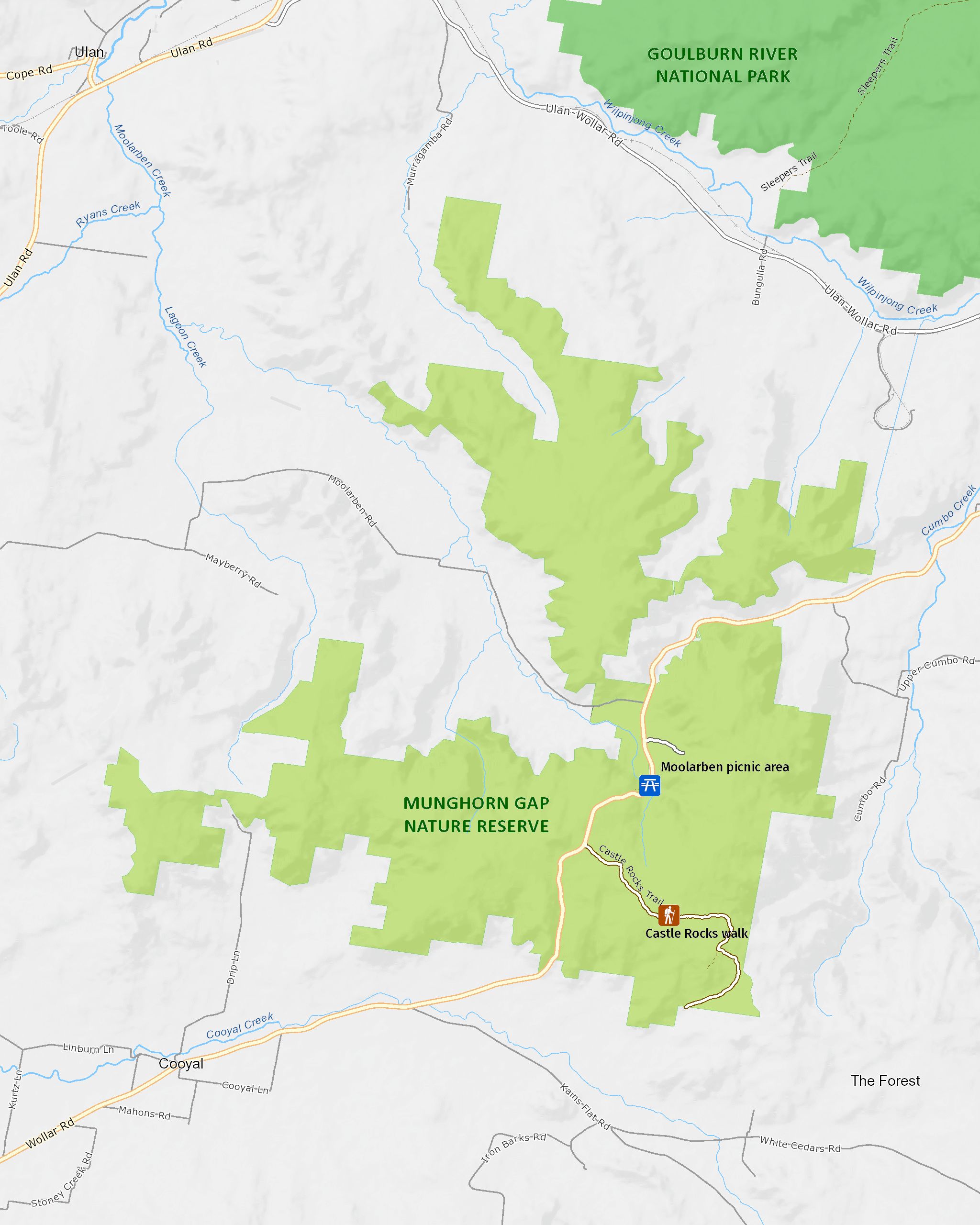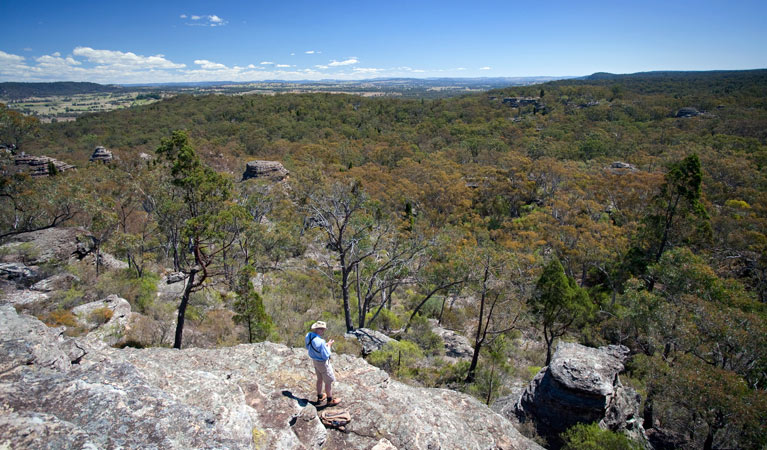Munghorn Gap Nature Reserve
Overview
Munghorn Gap Nature Reserve, in NSW Central Tablelands, is a great place for birdwatching, walking, barbecues and enjoying scenic views of its sandstone pagoda features.
Read more about Munghorn Gap Nature Reserve
Munghorn Gap Nature Reserve is a particularly important place for Wiradjuri people. The second oldest nature reserve in Australia is steeped in Aboriginal heritage. It protects an area of sandstone pagoda country where striking natural rock formations jut from the bushland-like ancient ruins. Best viewed from the lookout, bring your walking boots and follow Castle Rocks walk. Pack a picnic lunch and have a meal with a view or return to Moolarben picnic area for a barbecue as a reward for your efforts.
Within this lovely landscape, 164 species of birds have been recorded. To increase your chances of spotting an endangered and rare regent honeyeater, bring along your birdwatching binoculars, although you won’t need them to see an emu.
Look out for discarded feathers on the ground – all these different birds probably cover every colour of the rainbow between them. And while you’re looking down, keep an eye out for a bower built by the male bowerbird to attract a mate.
Local alerts
For the latest updates on fires, closures and other alerts in this area, see https://www.nationalparks.nsw.gov.au/visit-a-park/parks/munghorn-gap-nature-reserve/local-alerts
Contact
- in the Country NSW region
Munghorn Gap Nature Reserve is always open but may have to close at times due to poor weather or fire danger.
-
-
Mudgee office
02 6370 9000
Contact hours: Monday to Friday, 9am to 4:30pm. - 27 Inglis Street, Mudgee NSW 2850
-
Email: npws.mudgee@environment.nsw.gov.au
-
Mudgee office
Visitor info
All the practical information you need to know about Munghorn Gap Nature Reserve.
Map

Map legend

Maps and downloads
Nearby towns
Mudgee (30 km)
Set in the Cudgegong River valley in Central West NSW, Mudgee is a charming historic town and a popular destination for wine enthusiasts keen to sample its award-winning reds and whites. From its many wineries and national parks to markets, festivals and activities for the kids, Mudgee has much to offer.
Gulgong (58 km)
Founded in the heady days of the Australian gold rush, Gulgong has approximately 130 buildings with National Trust classification. Take a self-guided walking tour of the town's historic sites.
Merriwa (113 km)
Merriwa is a unique and friendly rural town nestled in the Upper Hunter Valley. Situated on the Golden Highway, Merriwa is the ideal place for a stopover, as it is centrally located. In just two hours you can reach Mudgee, Dubbo, Newcastle and Tamworth.
Learn more
Munghorn Gap Nature Reserve is a special place. Here are just some of the reasons why:
Trading places

Munghorn Gap has been inhabited by Aboriginal people for over 12,000 years. Once a major trading route between the Blue Mountains and the plains, Munghorn Gap continues to be a significant place to local Wiradjuri people.
Let's get physical

Great Dividing Range stretches the length of Eastern Australia and creates an interface between the western plains and the mountains. Munghorn Gap is one of the lowest points of the range and lies on the extreme western edge of the Sydney-Bowen geological basin. Parts of the reserve drain into Cudgegong River and, in turn, the Macquarie River system.
- Castle Rocks walk It’s an easy hike along Castle Rocks walk to the lookout for wonderful scenic views of the sandstone pagoda features found at Munghorn Gap Nature Reserve.
Birds of a feather

As far as birdwatchers are concerned, Munghorn Gap is a happening place to go twitching. Over 164 different species of birds inhabit the reserve either permanently or seasonally, and many of these are rare and uncommon. They come in all shapes and sizes, from Australia's tallest bird, the emu, to the country's smallest, the 8-9cm weebill. Many are brightly coloured, such as rare scarlet honeyeaters and flame robins, while others like jackie winters and tree martins are more subdued in appearance. Bowerbirds and lyrebirds can be seen in Munghorn Gap along with national favourites like kookaburras, magpies and galahs. Birds of prey include wedge-tailed eagles, whistling kites, collared sparrowhawks, peregrine falcons and brown goshawks. After dark the boobook and owls - powerful, barking, and barn -take over for the nightly hunt.
- Castle Rocks walk It’s an easy hike along Castle Rocks walk to the lookout for wonderful scenic views of the sandstone pagoda features found at Munghorn Gap Nature Reserve.
- Moolarben picnic area Moolarben picnic area, at Munghorn Gap Nature Reserve, is a great place to picnic, barbecue and relax. Enjoy light hiking? Castle Rocks walk is close by.
Back and forth

After Europeans settled in the region, Munghorn Gap became a route for horse and bullock teams connecting Wollar, Merriwa and Mudgee. Evidence of past blacksmithing, timber-cutting, peat and coal mining, prospecting, and quarrying can still be found in and around the reserve.
Education resources (1)
What we're doing
Munghorn Gap Nature Reserve has management strategies in place to protect and conserve the values of this park. View the detailed park and fire management documents.

